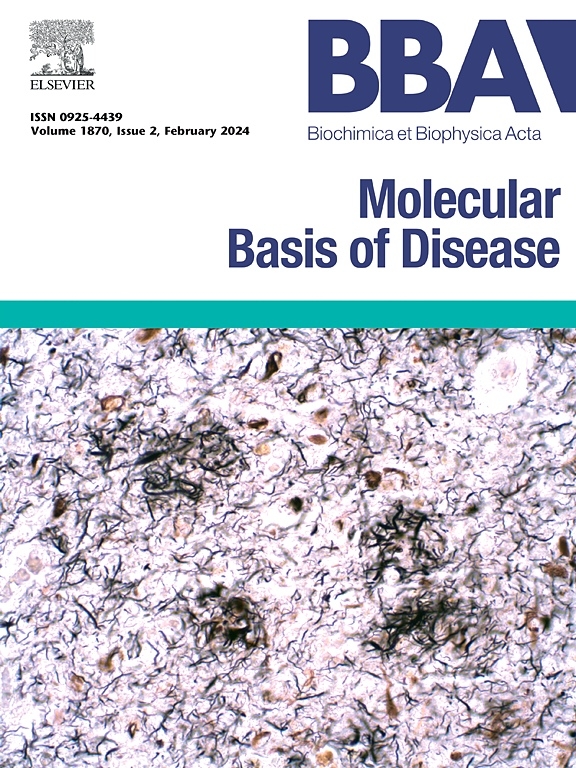PRAG1 promotes cholangiocyte epithelial-mesenchymal transition and liver fibrosis in biliary atresia
IF 4.2
2区 生物学
Q2 BIOCHEMISTRY & MOLECULAR BIOLOGY
Biochimica et biophysica acta. Molecular basis of disease
Pub Date : 2025-07-30
DOI:10.1016/j.bbadis.2025.167994
引用次数: 0
Abstract
Biliary atresia (BA) is a severe pediatric liver disease in which progressive liver fibrosis (LF) significantly affects the prognosis. Epithelial-mesenchymal transition (EMT) is considered a key factor in the development and progression of LF. This study aimed to investigate the role and mechanism of PEAK1-related kinase activating pseudokinase 1 (PRAG1) in the EMT-related LF process in BA. We found that the expression of PRAG1 was significantly elevated in both patients with BA and the bile duct ligation (BDL) model, and predominantly localized on biliary epithelial cells. Also, the expression of PRAG1 positively correlated with the cholangiocyte marker KRT19 and the mesenchymal marker ACTA2, and increased with the severity of fibrosis. In human intrahepatic biliary epithelial cells (HIBECs), PRAG1 promoted the expression of mesenchymal markers (VIM and ACTA2) and fibrosis markers (COL1A1 and FN1), inhibited the expression of the epithelial marker CDH1, and enhanced cell proliferation. The key factor of EMT-SNAIL1 presented increased expression and delayed degradation after overexpression of PRAG1. Moreover, we identified PRAG1 could bind with F-box protein 11 (FBXO11) and subsequently reversed FBXO11-mediated inhibition of SNAIL1 protein expression, cell proliferation, and the EMT phenotype. This study provides the potential role of PRAG1 in the mechanisms underlying the LF progression of BA.
PRAG1促进胆道闭锁的胆管细胞上皮-间质转化和肝纤维化
胆道闭锁(BA)是一种严重的儿童肝脏疾病,进行性肝纤维化(LF)显著影响预后。上皮-间质转化(Epithelial-mesenchymal transition, EMT)被认为是LF发生发展的关键因素。本研究旨在探讨peak1相关激酶激活伪激酶1 (PRAG1)在BA emt相关LF过程中的作用及机制。我们发现,在BA和胆管结扎(BDL)模型患者中,PRAG1的表达均显著升高,且主要局限于胆道上皮细胞。PRAG1的表达与胆管细胞标志物KRT19、间充质标志物ACTA2呈正相关,且随纤维化程度的加重而升高。在人肝内胆道上皮细胞(HIBECs)中,PRAG1促进间充质标志物(VIM和ACTA2)和纤维化标志物(COL1A1和FN1)的表达,抑制上皮标志物CDH1的表达,增强细胞增殖。过表达PRAG1后,关键因子EMT-SNAIL1表达增加,降解延迟。此外,我们发现PRAG1可以与F-box蛋白11 (FBXO11)结合,随后逆转FBXO11介导的对SNAIL1蛋白表达、细胞增殖和EMT表型的抑制。这项研究提供了PRAG1在BA的LF进展机制中的潜在作用。
本文章由计算机程序翻译,如有差异,请以英文原文为准。
求助全文
约1分钟内获得全文
求助全文
来源期刊
CiteScore
12.30
自引率
0.00%
发文量
218
审稿时长
32 days
期刊介绍:
BBA Molecular Basis of Disease addresses the biochemistry and molecular genetics of disease processes and models of human disease. This journal covers aspects of aging, cancer, metabolic-, neurological-, and immunological-based disease. Manuscripts focused on using animal models to elucidate biochemical and mechanistic insight in each of these conditions, are particularly encouraged. Manuscripts should emphasize the underlying mechanisms of disease pathways and provide novel contributions to the understanding and/or treatment of these disorders. Highly descriptive and method development submissions may be declined without full review. The submission of uninvited reviews to BBA - Molecular Basis of Disease is strongly discouraged, and any such uninvited review should be accompanied by a coverletter outlining the compelling reasons why the review should be considered.

 求助内容:
求助内容: 应助结果提醒方式:
应助结果提醒方式:


